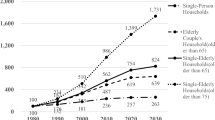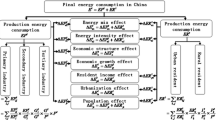Abstract
In China, the proportion of elderly population is growing, influencing economic development and energy consumption. Our study investigates the relationship between population aging and energy consumption in China from 1997 to 2020, considering both short and long-term effects. The analysis employs the pooled mean group (PMG) estimation and explores the underlying mechanisms using mediating effects and threshold effects models. The PMG results reveal a negative long-term impact of population aging on energy consumption, indicating that a 1% increase in population aging leads to a 0.348% decrease in energy consumption. Additionally, GDP per capita and capital stock exhibit positive correlations with energy consumption, while the industrial structure shows a negative correlation. Technological progress is found to significantly increase energy consumption. The mechanism analysis suggests that the mediating role of scale and technological effects contributes to the negative effect of population aging on energy consumption. Furthermore, a nonlinear relationship between population aging and energy consumption is observed, influenced by both population size and technological progress. The policy implications call for a comprehensive approach that addresses elderly population growth, enhances energy efficiency, and promotes sustainable technologies to ensure sustainable economic development.

Similar content being viewed by others
Data availability
The datasets used and/or analyzed during the current study are available from the corresponding author on reasonable request. All data generated or analyzed during this study are included in this published article.
References
Balsalobre-Lorente D, Sinha A, Driha OM et al (2021) Assessing the impacts of ageing and natural resource extraction on carbon emissions: A proposed policy framework for European economies. J Clean Prod 296:126470
Breusch TS, Pagan AR (1980) The lagrange multiplier test and its applications to model specification in econometrics. Rev Econ Stud 47(1):239. https://doi.org/10.2307/2297111
Dalton M, O’Neill B, Prskawetz A et al (2008) Population aging and future carbon emissions in the United States. Energy Econ 30:642–675
Danish, Zhang JW, Hassan ST et al (2019) Toward achieving environmental sustainability target in Organization for Economic Cooperation and Development countries: The role of real income, research and development, and transport infrastructure. Sustain Dev 28(1):83–90
Danish, Hassan ST (2022) Investigating the interaction effect of urbanization and natural resources on environmental sustainability in Pakistan. International J Environ Sci Technol 1–8. https://doi.org/10.1007/s13762-022-04497-x
Fan J, Zhou L, Zhang Y et al (2021) How does population aging affect household carbon emissions? Evidence from Chinese urban and rural areas. Energy Econ 100:105356
Gao P, Wang Y, Zou Y, Su X, Che X, Yang X (2022) Green technology innovation and carbon emissions nexus in China: Does industrial structure upgrading matter? Front Psychol 13:951172
Gelenbe E, Caseau Y (2015) The impact of information technology on energy consumption and carbon emissions[J]. Ubiquity 2015(June):1–15. https://doi.org/10.1145/2755977
Guo W, Sun T, Dai H (2016) Effect of Population Structure Change on Carbon Emission in China. Sustainability 8(3):225
Guo L, Song Y, Zhao S et al (2022) Dynamic Linkage between Aging, Mechanizations and Carbon Emissions from Agricultural Production. Int J Environ Res Public Health 19(10):6191
Han X, Wei C, Cao GY (2022) Aging, generational shifts, and energy consumption in urban China. Proc Natl Acad Sci 119(37):e2210853119. https://doi.org/10.1073/pnas.2210853119
Hanif I (2018) Economics-energy-environment nexus in Latin America and the Caribbean. Energy 141:170–178
Hu J, Wang M, Cheng Z, Yang ZS (2020) Impact of marginal and intergenerational effects on carbon emissions from household energy consumption in China. J Clean Prod:273123022. https://doi.org/10.1016/j.jclepro.2020.123022
Huang Y, Shigetomi Y, Chapman A et al (2019) Uncovering Household Carbon Footprint Drivers in an Aging, Shrinking Society. Energies 12(19):3745
Institute of Medicine (US) Committee on the Long-Run Macroeconomic Effects of the Aging U.S. Population (2012) Aging and the Macroeconomy: Long-Term Implications of an Older Population. Washington (DC): National Academies Press (US); 2012 Dec 10. 6, Aging, Productivity, and Innovation
Jarzebski MP, Elmqvist T, Gasparatos A et al (2021) Ageing and population shrinking: implications for sustainability in the urban century. Npj Urban Sustain 1:17
Jin W, Zhang ZX (2014) Quo vadis? Energy consumption and technological innovation[J]. Crawford School of Public Policy, The Australian National University, CCEP Working Paper 1412. https://doi.org/10.2139/ssrn.2731398
Kao C (2000) Spurious regression and residual-based tests for cointegration in panel data. J Econ 90(1):1–44
Kim J, Lim H, Jo H-H (2020) Do Aging and Low Fertility Reduce Carbon Emissions in Korea? Evidence from IPAT Augmented EKC Analysis. Int J Environ Res Public Health 17(8):2972
Li W, Qi X, Zhao X (2018) Impact of population aging on carbon emission in China: A panel data analysis. Sustainability 10(7):2458. https://doi.org/10.3390/su10072458
Liang L, Huang C, Hu Z (2023) Industrial structure optimization, population agglomeration, and carbon emissions—Empirical evidence from 30 provinces in China. Front Environ Sci 10:1078319
Liddle B (2013) Impact of population, age structure, and urbanization on carbon emissions/energy consumption: evidence from macro-level, cross-country analyses[J]. Popul Environ 35:1–2
Liu Y, Hao Y (2018) The dynamic links between CO2 emissions, energy consumption and economic development in the countries along “the Belt and Road.” Sci Total Environ 645:674–683
Liu H, Wang C, Tian M et al (2019) Analysis of regional difference decomposition of changes in energy consumption in China during 1995–2015. Energy 171:1139–1149
Menz T, Welsch H (2012) Population aging and carbon emissions in OECD countries: Accounting for life-cycle and cohort effects. Energy Econ 34:842–849
Nawaz MA, Hussain MS, Kamran HW et al (2020) Trilemma association of energy consumption, carbon emission, and economic growth of BRICS and OECD regions: quantile regression estimation. Environ Sci Pollut Res 28:16014–16028
NBS (2020) China provincial statistical. Yearbook China Statistics Press
O’Neill BC, Liddle B, Jiang L et al (2012) Demographic change and carbon dioxide emissions. Lancet 380:157–164
Ozcan B, Temiz M (2022) An empirical investigation between renewable energy consumption, globalization and human capital: A dynamic auto-regressive distributive lag simulation[J]. Renew Energy 193:195–203
Pedroni P (1999) Critical Values for Cointegration Tests in Heterogeneous Panels with Multiple Regressors. Oxford Bull Econ Stat 61:653–670
Pesaran MH (2004) General diagnostic tests for cross section dependence in panels. Cambridge Working Papers in Economics 69(7):1240
Pesaran MH, Shin Y, Smith RP (1999) Pooled mean group estimation of dynamic heterogeneous panels. J Am Stat Assoc 94(446):621–634
Ribeiro HV, Rybski D, Kropp JP (2019) Effects of changing population or density on urban carbon dioxide emissions. Nat Commun 10:3204
Sarwar A, Hanif U (2018) Pakistan's electricity demand analysis 1975-2016. Empir Econ Rev 1
Shen X, Liang J, Cao J, Wang Z (2022) How Population Aging Affects Industrial Structure Upgrading: Evidence from China. Int J Environ Res Public Health 19:16093
Sun H, Chen F (2022) The impact of green finance on China’s regional energy consumption structure based on system GMM. Resour Policy 76:102588
Tang HY, Zhang JQ, Fan F, Wang ZW (2022) High-speed rail, urban form, and regional innovation: a time-varying difference-in-differences approach. Technol Anal Strateg Manag:1–15
Tarazkar MH, Dehbidi NK, Ozturk I et al (2020) The impact of age structure on carbon emission in the Middle East: the panel autoregressive distributed lag approach. Environ Sci Pollut Res 28:33722–33734
Wang Q, Wang L (2021) The nonlinear effects of population aging, industrial structure, and urbanization on carbon emissions: A panel threshold regression analysis of 137 countries. J Clean Prod 287:125381
Wang Y, Kang Y, Wang J et al (2017) Panel estimation for the impacts of population-related factors on CO 2 emissions: A regional analysis in China. Ecol Ind 78:322–330
Wei L, Liu Z (2022) Spatial heterogeneity of demographic structure effects on urban carbon emissions. Environ Impact Assess Rev 95:106790
Wei T, Zhu Q, Glomsrød S (2018) Ageing Impact on the Economy and Emissions in China: A Global Computable General Equilibrium Analysis. Energies 11:1–2
Yang T, Wang Q (2020) The nonlinear effect of population aging on carbon emission-Empirical analysis of ten selected provinces in China. Sci Total Environ 740:140057
Yang Y, Zhao T, Wang Y et al (2015) Research on impacts of population-related factors on carbon emissions in Beijing from 1984 to 2012. Environ Impact Assess Rev 55:45–53
York R (2007) Demographic trends and energy consumption in European Union Nations, 1960–2025. Soc Sci Res 36:855–872
Yu M, Bo M, Rong Li (2022) Analysis of China’s urban household indirect carbon emissions drivers under the background of population aging[J]. Struct Chang Econ Dyn 60:114–125
Zang Z, Zou X, Song Q et al (2018) Analysis of the global carbon dioxide emissions from 2003 to 2015: convergence trends and regional contributions. Carbon Manag 9(1):45–55
Zhang C, Tan Z (2016) The relationships between population factors and China’s carbon emissions: Does population aging matter? Renew Sustain Energy Rev 65:1018–1025
Zhang F, Deng X, Phillips F et al (2020) Impacts of industrial structure and technical progress on carbon emission intensity: Evidence from 281 cities in China. Technol Forecast Soc Chang 154:119949
Zhang J, Tang H, Bao M (2023) Can environmental protection policies promote regional innovation efficiency: a difference-in-differences approach with continuous treatment. Environ Sci Pollut Res 30(1):1357–1373
Zhao J, Jiang Q, Dong X et al (2022) How does industrial structure adjustment reduce CO2 emissions? Spatial and mediation effects analysis for China. Energy Econ 105:105704
Zheng H, Long Y, Wood R et al (2022) Author Correction: Ageing society in developed countries challenges carbon mitigation. Nat Clim Chang 12:593–593
Acknowledgements
We would like to thank all the reviewers for their helpful comments and suggestions. We also acknowledge supports from the Major Project of the National Social Science Foundation of China (19ZDA082), the Young Project of the National Natural Science Foundation of China (72103027) and the Fundamental Research Funds for the Central Universities (2022CDSKXYJG007).
Funding
This work is financially supported by the Major Project of the National Social Science Foundation of China (19ZDA082), the Young Project of the National Natural Science Foundation of China (72103027) and the Fundamental Research Funds for the Central Universities (2022CDSKXYJG007).
Author information
Authors and Affiliations
Contributions
All authors contributed to the study conception and design. Specific contributions for each author are below.
Yuehan Yu: Conceptualization, Data curation, Formal analysis, Methodology, Software, Investigation, Writing-original draft.
Hao Feng: Conceptualization, Methodology, Writing-review, Editing, Supervision.
Rong Yuan: Data curation, Formal analysis, Methodology.
Corresponding author
Ethics declarations
Ethical approval
Not applicable.
Consent to participate
Not applicable.
Consent to publish
Not applicable.
Competing interests
The authors have no relevant financial or non-financial interests to disclose.
Additional information
Responsible Editor: Baojing Gu
Publisher's note
Springer Nature remains neutral with regard to jurisdictional claims in published maps and institutional affiliations.
Supplementary Information
Below is the link to the electronic supplementary material.
Rights and permissions
Springer Nature or its licensor (e.g. a society or other partner) holds exclusive rights to this article under a publishing agreement with the author(s) or other rightsholder(s); author self-archiving of the accepted manuscript version of this article is solely governed by the terms of such publishing agreement and applicable law.
About this article
Cite this article
Yu, Y., Feng, H. & Yuan, R. How does population aging affect China’s energy consumption?. Environ Sci Pollut Res 30, 102673–102686 (2023). https://doi.org/10.1007/s11356-023-29507-4
Received:
Accepted:
Published:
Issue Date:
DOI: https://doi.org/10.1007/s11356-023-29507-4




